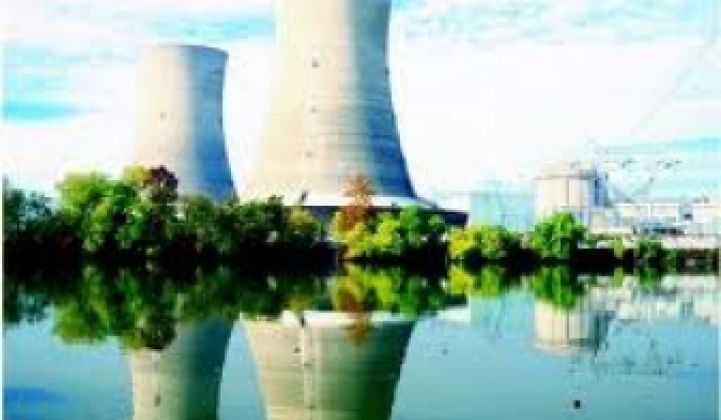Uranium supplies won't be a hindrance to the expansion of nuclear, but finance and inadequate planning might, according to a report from MIT today.
The study, a follow-on to studies conducted by the university in 2003 and 2009, focuses largely on the fuel cycle for nuclear plants. (Get the PDF here.)
The good news for nuclear proponents? The country has access to a lot of uranium, and even cost increases wouldn't change the cost of nuclear power. A typical light water reactor -- the type of units that produce electricity in the U.S. -- only uses 200 tons of fuel per year, and the cost of uranium only represents around 2 percent to 4 percent of the cost of electricity from nuclear plants.
Even if the number of light water reactors were to grow tenfold, it would only increase the cost of the fuel by 50 percent and would not materially change the price of power drawn from these plants. As a result, the report recommends focusing the efforts of the industry, and a large portion of research, on enhancing light water reactors.
"There is no shortage of uranium sources," said Ernie Moniz, director of the MIT Energy Initiative, one of several who authored the report. "The management of spent nuclear fuel is sound and so is geologic isolation."
"For the next several decades, the light water reactors are the way to go," Moniz, who spoke to us late last year about light water reactors, added. Dan Kammen at U.C. Berkeley has also said that nuclear needs to be part of the future energy mix.
Uranium supplies could be further extended with strategies to use depleted uranium. Now, the U.S. follows a once-through fuel strategy where uranium ore is converted into enhanced uranium and depleted uranium. The enhanced uranium is converted to fuel, becomes spent nuclear fuel and then gets stored and sequestered. There is approximately ten to 20 times as much depleted uranium produced in that first step than enhanced uranium.
Some have proposed inserting depleted uranium into fast spectrum reactors that could turn it into fissionable materials. Fast spectrum reactors, however, remain in the planning stages, would require a large amount of plutonium, and may not be economical.
Instead, the study suggested a new route: take depleted uranium and add it to a reactor at the same rate as the nuclear fuel is consumed. Nonetheless, it is not known whether these enriched uranium-initiated breeder reactors would be economical or possible either.
"We don't know whether the spent nuclear fuel from light water reactors is a resource or waste material," Moniz said.
The downside? Cost remains a huge problem for the nuclear industry. The report estimates that overnight cost -- i.e., the cost of a plant minus financing during construction -- is around $4,000 a kilowatt, compared to $2,300 per kilowatt for coal and $850 for natural gas. A nuclear facility at this level could produce power for 8.4 cents per kilowatt hour compared to 6.2 cents per kilowatt hour for coal and 4.2 cents to 8.7 cents for natural gas.
If the risk premium built into those nuclear figures were eliminated, the price of nuclear could be dropped to 6.6 cents, according to the report.
But eliminating that risk isn't easy.
"The track record for the construction costs of nuclear plants completed in the U.S. during the 1980s and early 1990s was poor. Actual costs were far higher than had been projected. Construction schedules experienced long delays, which, together with increases in interest rates at the time, resulted in high financing charges. Whether the lessons learned from the past can be factored into the construction of future plants has yet to be seen," the report states.
Critics such as Mark Cooper at the University of Vermont say the real costs tend to range toward $7,000 to $10,000 per kilowatt. State support of these projects turns into "nuclear socialism," Cooper says. Amory Lovins of the Rocky Mountain Institute says costs have escalated beyond what proponents claim.
Solar and wind advocates, meanwhile, claim that their power can cost even less. Wind turbines can produce power for 4 to 6 cents per kilowatt hour. Additionally, the interest incurred during construction that overnight costs exclude is lower due to fewer delays. Wind and solar, though, also depend on subsides and environmental conditions, etc. The arguments over which will be the cheaper fuel source in the future, hence, will roll on.
To ameliorate the risk, MIT proposes that the U.S. government provides helper incentives to the next seven to ten nuclear projects that are proposed. The White House has already begun to issue loan guarantees to some nuclear projects.
"The first-mover incentives put in place in the U.S. since 2005 have been implemented slowly. This should be accelerated for the purposes of determining construction costs and schedules at multiple plants," the report stated. "The incentives should not be extended beyond the first-mover program (i.e., for 7-10 plants)."
Another issue: the U.S. has not made adequate plans for storing and disposing of nuclear waste. Spent nuclear fuel takes 40 to 60 years to cool before it can be permanently sequestered, according to Charles Forsberg, executive director of the MIT fuel cycle study.
The time horizon of a century should be contemplated when drawing up fuel cycle strategies.



